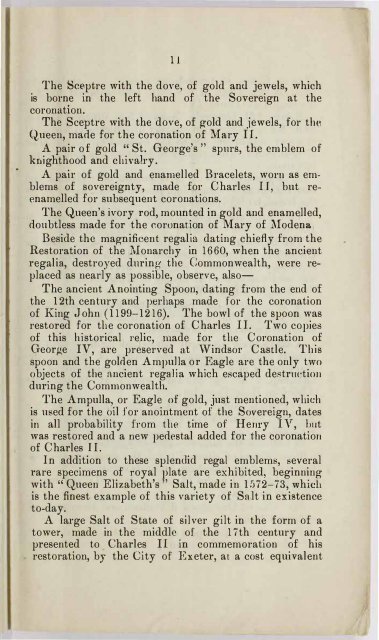Authorised Guide to the Tower of London
Create successful ePaper yourself
Turn your PDF publications into a flip-book with our unique Google optimized e-Paper software.
11<br />
The Sceptre with <strong>the</strong> dove, <strong>of</strong> gold ancl jewels, which<br />
is borne in <strong>the</strong> left hand <strong>of</strong> <strong>the</strong> Sovereign at <strong>the</strong><br />
coronation.<br />
The Sceptre with <strong>the</strong> dove, <strong>of</strong> gold and jewels, for <strong>the</strong><br />
Queen, made for <strong>the</strong> coronation <strong>of</strong> Mary II.<br />
A pair <strong>of</strong> gold "St. George's " spurs, <strong>the</strong> emblem <strong>of</strong><br />
knighthood and chivalry.<br />
A pair <strong>of</strong> gold and enamelled Bracelets, worn as emblems<br />
<strong>of</strong> sovereignty, made for Charles II, but reenamelled<br />
for subsequent coronations.<br />
The Queen's ivory rod, mounted in gold and enamelled,<br />
doubtless made for <strong>the</strong> coronation <strong>of</strong> Mary <strong>of</strong> Modena<br />
Beside <strong>the</strong> magnificent regalia dating chiefly from <strong>the</strong><br />
Res<strong>to</strong>ration <strong>of</strong> <strong>the</strong> Monarchy in 1660, when <strong>the</strong> ancient<br />
regalia, destroyed during <strong>the</strong> Commonwealth, were replaced<br />
as nearly as possible, observe, also-<br />
The ancient Anointing Spoon, dating from <strong>the</strong> end <strong>of</strong><br />
<strong>the</strong> 12th century and perhaps made for <strong>the</strong> coronation<br />
<strong>of</strong> King John (1199-1216). The bowl <strong>of</strong> <strong>the</strong> spoon was<br />
res<strong>to</strong>red for <strong>the</strong> coronation <strong>of</strong> Charles II. Two copies<br />
<strong>of</strong> this his<strong>to</strong>rical relic, made for <strong>the</strong> Coronation <strong>of</strong><br />
George IV, are preserved a.t Windsor Castle. This<br />
spoon and <strong>the</strong> golden Ampulla or Eagle are <strong>the</strong> only two<br />
objects <strong>of</strong> <strong>the</strong> n,ncient regalia which escaped deRtrnction<br />
during <strong>the</strong> Commonwealth.<br />
The Ampulla, or Eagle <strong>of</strong> gold, just mentioned, which<br />
is used for <strong>the</strong> oil for anointment <strong>of</strong> <strong>the</strong> Sovereign, dates<br />
in all probability from <strong>the</strong> time <strong>of</strong> Henry IV, but<br />
was res<strong>to</strong>red and a new pedestal added for <strong>the</strong> coronation<br />
<strong>of</strong> Charles II.<br />
In addition <strong>to</strong> <strong>the</strong>se splendid regal emblems, several<br />
rare specimens <strong>of</strong> royal plate are exhibited, beginning<br />
with " Queen Elizabeth's " Salt, made in 1572-73, which<br />
is <strong>the</strong> finest example <strong>of</strong> this variety <strong>of</strong> S::i.lt in existence<br />
<strong>to</strong>-day.<br />
A large Salt <strong>of</strong> State <strong>of</strong> silver gilt in <strong>the</strong> form <strong>of</strong> a<br />
<strong>to</strong>wer, made in <strong>the</strong> middle <strong>of</strong> <strong>the</strong> 17th century and<br />
presented <strong>to</strong> Charles II in commemoration <strong>of</strong> his<br />
res<strong>to</strong>ration, by <strong>the</strong> City <strong>of</strong> Exeter, at a cost equivalent



